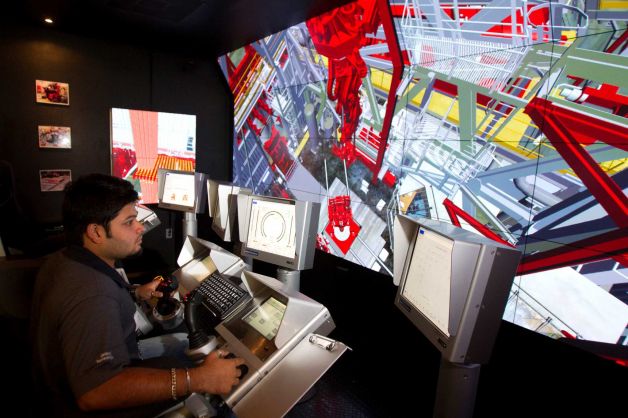It’s commonly known that immersive 3D simulators are one of the best ways to train heavy equipment operators, and offshore oil rigs are some of the heaviest pieces of equipment out there. Simulators allow trainees to master the controls of these massive machines that they will be operating, as well as learn all of the techniques and knowledge that will be required of them on a real rig. Simulation-based training allows operators to learn the necessary skills and practice them until they are mastered, all in a safe and risk-free virtual environment.
One of the largest and most complicated pieces of heavy equipment to operate is an offshore oil rig. Proper operation of these rigs is imperative, as exemplified by the Deepwater Horizon blowout and subsequent catastrophe that occurred in the Gulf of Mexico in 2010. This accident caused the death of 11 workers, injuring 17 others, and spilled approximately 4.9 million barrels of oil into the ocean, equating to significant damage, both financially and environmentally. When the risks are this high, proper training is of the utmost importance, and 3D training simulators are helping to produce operators that can perform their jobs faster, safer, and more efficiently.
Oil Rig Operator Training Simulator
After the Deepwater Horizon blowout in 2010, new Federal Safety and Environmental Management Systems rules were put in place that mandate that employers provide more safety and operations training to their employees, and 3D training simulators are playing a big part in providing that training. Norwegian oil services company, Aker Solutions, recently showed off their oil rig operator training simulator, that will help produce highly-qualified operators.
 |
Oil Rig Training Simulator |
Drilling, Well Control, and Crane Operator Simulators
Transocean, the world’s largest offshore drilling contractor, recently opened a 2 world-class training centers in Brazil that include training simulators for drilling, well control, and crane operators.
“It’s vital that we continue to deliver efficient and effective solutions to our customers’ drilling needs, and our offices and training center support this goal by developing our people to be the best they can be.” – Steve Newman, President and CEO of Transocean.
In Kuala Lumpur, Malaysia, Transocean has opened another facility that will provide training for 1,200 personnel a year, with more than 20 different simulation-based courses. Currently the equipment includes a crane simulator, conventional drilling simulator, and a well-control simulator, with two cyber-chair drilling simulators in development.
 |
| Transocean Drilling Simulator |
Well Intervention Simulator
Shell recently launched their well intervention simulator, at the Shell Exploration & Production International Centre in Rijswijk, The Netherlands. Part of their Advanced Well Control Course, the simulator focuses on command-and-control types of scenarios, in addition to specific equipment operation. Shell believes that by incorporating simulator time into their curriculum, students have an increased level of engagement and the learning experiences are enhanced.
 |
| Well Intervention Simulator |
Oil Rig Training Simulator Return on Investment
With all of the inherent risks imposed by oil drilling, it’s no wonder that so many companies are turning to 3D training simulators to help prevent costly accidents. Operator skill levels can be taught, measured, and assessed in a risk-free virtual world where accidents don’t cost millions of dollars, damage equipment and the environment, and cause injury or death. A well-trained workforce is more likely to increase a company’s revenue and decrease the number of real-world mishaps.
